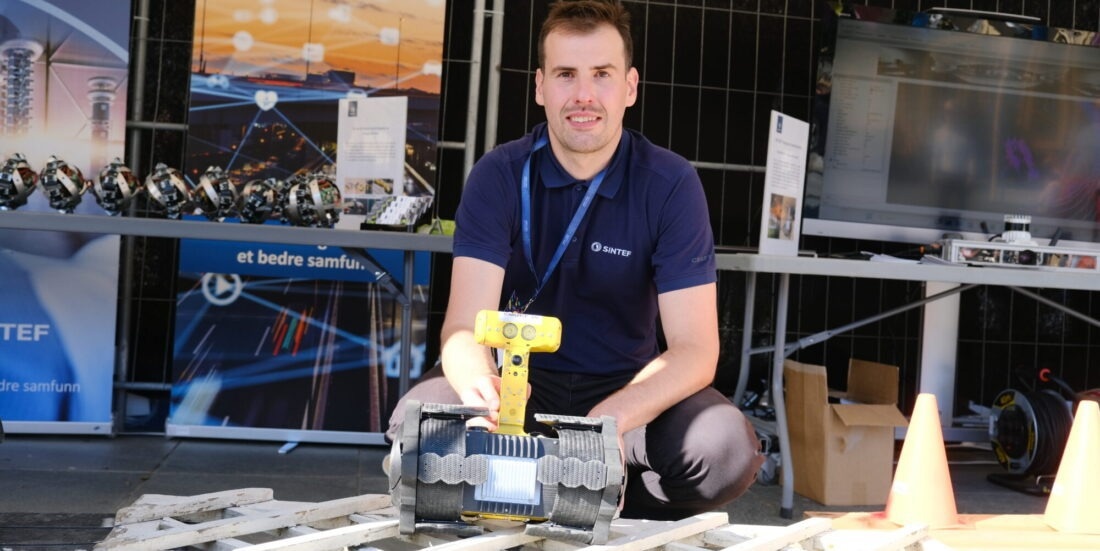Reviewed by Frances BriggsOct 10 2025
When buildings collapse, a small robot named "Smurf" could be among the first to search for survivors. Developed by researchers at SINTEF, the compact robot is equipped with sensors that allow it to use its eyes, ears, and nose to locate people trapped beneath debris.
 Researcher Jan Sramota shows off the rescue robot during the Skaperfest event, a Maker festival in Trondheim. Image Credit: Emma Sæter/Norwegian SciTech News
Researcher Jan Sramota shows off the rescue robot during the Skaperfest event, a Maker festival in Trondheim. Image Credit: Emma Sæter/Norwegian SciTech News
We couldn’t paint the robot blue like a traditional Smurf. It had to be painted with three reflective coats of yellow paint so that it’s clearly visible.
Jan Sramota, Researcher, SINTEF
Sramota serves as a researcher at SINTEF and is a member of the team responsible for the development of the rescue robot. This robot is designed to operate in the aftermath of earthquakes, landslides, floods, and various other natural disasters.
The rescue teams can deploy the yellow Smurfs when the circumstances become excessively hazardous or when there are more locations to cover than teams available.
Support for Rescue Dogs
When an earthquake hits, you can’t search every single building immediately. You have to decide where the most survivors are likely to be and start there.
Jan Sramota, Researcher, SINTEF
To help with this process, search and rescue teams often use trained dogs.
The problem is, first of all, that the environment is not very safe for dogs. There’s a lot of broken glass, sharp objects, and maybe leaking gas. The second is that the dogs need to take breaks. A half-hour search is very tiring, so then a dog needs to rest.
Jan Sramota, Researcher, SINTEF
Norwegian-Japanese Collaboration
The Smurf is one of several technologies being created within a European research initiative known as CURSOR. The name SMURF is an acronym for Soft Miniaturized Underground Robotic Finders.
It’s a small robot that has been developed from scratch. SINTEF has collected the technology used for it, while researchers at Tohoku University in Japan built the actual robot.
Jan Sramota, Researcher, SINTEF
When communication networks go down after a disaster, first responders need to bring all necessary tools with them. One part of the CURSOR project focuses on drones that can hover over affected areas, equipped with cameras, ultra-bright lights to simulate daylight, and two-way communication systems.
Released From Drones
Drones also deliver the Smurf robots directly to the specified location. This allows the search for survivors to commence before it is safe for human teams to enter the debris.
The wheels of the Smurfs are engineered to endure impacts from being dropped from a height by the drones onto the ground.
Each SMURF is equipped with lights, a standard camera, an infrared camera to detect heat, and a smell sensor that can distinguish between humans and animals, as well as between casualties and survivors.
Additionally, they feature built-in two-way communication. This enables the emergency scene commander to communicate with people who have been located, assess their condition, and establish a more informed basis for prioritizing rescues.
An Affordable Solution
One of the key criteria considered by the researchers throughout the project is that the robots must be compact and cost-effective. The anticipated price will be approximately NOK 50,000, or just under $5000 USD, when they commence series production.
In the past, we always tried to build a robot so well that it would never get stuck. That made them really expensive, and they always get stuck sooner or later. That's why we’ve focused on quantity and not making them so expensive that rescuers are afraid of losing them.
Jan Sramota, Researcher, SINTEF
Sramota has listened to accounts of individuals who are meant to attempt to preserve lives following an accident or catastrophe, yet have ventured into perilous zones due to the belief that someone may be present.
They’ve risked their lives to get three meters further in and look down into a hole where there could be someone. Now we can send a rescue robot instead. You risk 50,000 kroner instead of a person's life.
Jan Sramota, Researcher, SINTEF
Tested in Trondheim
Sramota highlights that the initiative has provided individuals present at the scene with the chance to participate in the project and evaluate both the Smurfs and the other innovations within the CURSOR project.
The team has tested the Smurfs with the Trøndelag Fire and Rescue Service, where they conducted an exercise to find survivors in a building that had collapsed.
The robots have garnered significant attention, making them one of the select research projects showcased in the EU pavilion at the World Expo in Osaka this summer. Sramota recognizes that receiving an invitation to this event is indeed a remarkable honor.